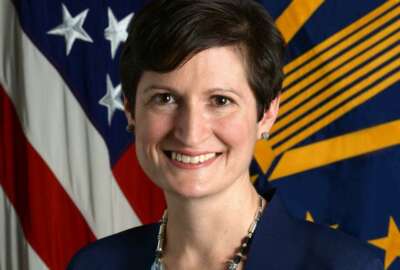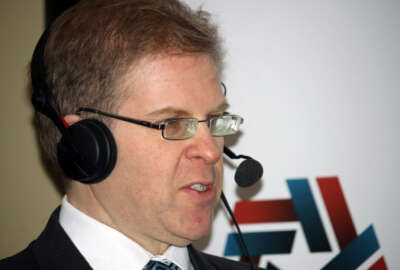
From 9/11 to Hurricane Sandy, she’s been at the forefront of FEMA responses
Continuing its week-long series of interviews with recent Presidential Rank Award winners. Temin's guest for this interview probably knows as much about disasters...
Continuing its week-long series of interviews with recent Presidential Rank Award winners. Temin’s guest for this interview probably knows as much about disasters — and federal responses to them — as anyone. Her experience with the Federal Emergency Management Agency dates back to debris management after 9/11. Now she’s the FEMA region 3 administrator. Enjoy the Federal Drive with Tom Temin interview with MaryAnn Tierney.
Interview transcript:
Tom Temin
You have been in emergency management a long time and even before FEMA, correct?MaryAnn Tierney
Yes, I have been in emergency management since 1999, where I started with the New York City emergency management.Tom Temin
All right. And your first immersion, I guess, in federal response was in the moments after 911. I kind of consider that the pre-Katrina FEMA, and there’s a different FEMA, in some ways, after Katrina. But let’s talk about the FEMA of the 911 era. What happened and what did you do in relation to the debris afterwards?MaryAnn Tierney
Yeah, well, I worked really closely with FEMA after 911, because I was one of the leads for the recovery operations that the city was undertaking. So we’re a couple of aspects of that. First, the debris operation, like you mentioned, moving debris from ground zero. I worked really closely with the Army Corps and with FEMA on that. And then also FEMA’s reimbursement program, the Public Assistance Program. I did a lot of work with our city agencies and FEMA on reimbursing the city for their costs associated with 911.Tom Temin
It sounds like there was a financial management and accounting type of task, but also a physical task working with people with front end loaders and dump trucks.MaryAnn Tierney
Yeah, that’s a really interesting aspect of emergency management is that it can involve both extensive field work, but also significant policy and desk work.Tom Temin
Yeah. And so what’s your educational background, experiential background that got you to where you could juggle both of those halves of the task?MaryAnn Tierney
Well, I went to American University, I have an undergraduate degree in political science. And while I was at American, I participated in several internships, including one with the D.C. Emergency Management Agency, and one with FEMA, back when I was in college. And then from there, like I mentioned, I worked at New York City Emergency Management. And while I was working full time, I went to NYU and received a graduate degree in public administration.Tom Temin
All right. And just going back to that 911 time, then you saw this, the aftermath anyhow, physically with your own two eyes?MaryAnn Tierney
Yeah, New York City Emergency Management was located in Seven World Trade Center. And so on the day of 911, that’s where I was in our emergency operations center.Tom Temin
And what prompted you to leave the city government and join FEMA?MaryAnn Tierney
Well, before I joined FEMA, I left New York City government for Philadelphia government. I was the emergency management director in Philadelphia, and I was there for about four years. And Philadelphia is where FEMA Region Three is located. And when the regional administrator position for FEMA Region Three opened up, somebody at FEMA called me and suggested that I apply. And that’s how I got into working at FEMA, through my personal emergency management network alerting me to the position, and then applying. And then, I’ve been the regional administrator at FEMA now, for over 12 years.Tom Temin
Got it. So you had a rep, in other words.MaryAnn Tierney
Well, emergency management is a really small community, especially at the more senior levels. And so it was nice for someone to alert me to the position, and of course, then I had to go through the whole SES process to apply and be qualified and approved.Tom Temin
Sure, we’re speaking with MaryAnn Tierney. She is Region Three administrator at FEMA and a recent presidential rank award recipient. And then, it wasn’t that long then till, I guess, Region Three was the main Response Center for Hurricane Sandy?MaryAnn Tierney
Yeah, so I started in Region Three and 2010. And Region Three is we cover the mid-Atlantic states, and there was, at the beginning of Hurricane Sandy, significant concern that Region Three would be severely impacted by that storm. Then unfortunately, for Region Three, unfortunately, for FEMA Region Two and New York and New Jersey, the storm shifted slightly north, and really was devastating to the New York, New Jersey metro area. And many people in Region Three, including myself, responded to Hurricane Sandy to support New York, New Jersey and FEMA Region Two.Tom Temin
Right, three and two are kind of, it’s a boundary in administrative standpoint, but really, it’s kind of one region in some sense, geographically, everything else.MaryAnn Tierney
The Northeast is a very compact region. In fact, I can see FEMA Region Two New Jersey, from my office in Center City, Philadelphia.Tom Temin
Right. And I want to talk about that. But first, I want to ask you, what do you think are the big differences between working at the city administrative level and at the federal level?MaryAnn Tierney
Yeah, that’s a really great question. At the city level, every day you’re directly interacting with citizens on a variety of daily challenges, water main breaks, building collapses, multi alarm fires, special events. So it’s very tactical. And then coming to FEMA. We do a lot of direct services, to individuals and communities through our disaster relief and recovery programs. But we also have a very extensive policy arm, we regulate the floodplain, we are involved in off site nuclear emergency planning. So the scope of what I do at the federal level is much broader, and the scale is much broader. I would say that’s the main difference, in my observation.Tom Temin
And what do you think it is that got the presidential rank award for you?MaryAnn Tierney
That’s a great question. It’s really humbling to have been bestowed this award, which was obviously a remarkable accomplishment for any senior executive in the federal government. And, for me, I look at it as really a reflection of my team. No leader does these things alone, and it really takes a whole team to lift you up, to lift the whole organization up. So I really credit the work of the FEMA Region Three team for my success and being recognized. And I think our collective success over the past 12 plus years, that I’ve been the Regional Administrator, that this is just a reflection of the team. You don’t do anything like this alone.Tom Temin
And it seems like FEMA has done a steady job of improving relationships between the federal entities and the local emergency management entities. I think Katrina, again, down in New Orleans, was a pressure test for that relationship, and for how response should work. Does that seem to have been a turning point in that management aspect of the intergovernmental relationship, do you think?MaryAnn Tierney
To be direct, even when I was working in New York City before Katrina, I had very excellent relationships with our FEMA Regional Office and the individuals from FEMA headquarters. Every organization has watershed moments, has moments that change the trajectory and the dynamic of that organization. And certainly, Hurricane Katrina was one of those events for FEMA. And FEMA, through congressional action and through organizational changes, made substantial adjustments to how they operate and their policies post Katrina. And I think that’s been reflected, as the agency is much more operationally focused or leans forward. Congress gave FEMA immense authority, post Katrina, to pre-position resources and people so that they were not going to be late to need. And I think, we continue that evolution through a variety of events, whether it was the Hurricane Sandy Recovery Improvement Act, or during COVID, and now post COVID. FEMA has made substantial adjustments to its operations. And part of the, I think, the ethos of emergency management is continuous learning and improvement. And I think FEMA has shown that over the years through many of its large events.Tom Temin
And do the regional administrators get together, either virtually or in person, periodically? And when you do, what do you talk about?MaryAnn Tierney
Yes, we are connected, almost daily, I talked to my regional counterparts. In fact, I was just this morning speaking to another regional administrator about an issue of common interests where we could partner. So we do get together regularly, we do calls as a group on a regular basis, because again, we’re all over the country. And then we convene, at least quarterly, for in person meetings. And just this past week, I was meeting with some of our regional administrators and our field leadership, where we were talking about areas of common interest in providing disaster operations to communities and survivors of post presidential declarations.Tom Temin
Sure, and what about relationships with private industry? Because one of the things that we’ve learned in recent disasters, in the last couple of decades, is that if you want certain things delivered, often companies have the logistics and the supplies there to a greater extent than the government could ever hope to.MaryAnn Tierney
Yeah, that’s a great question. I think, what I would kind of start with, is that emergency management is a team sport. And there are a lot of different partners that contribute to the success of responding to an emergency, and then eventually, recovering from it. So, government is one part of that solution, it’s not the only member on the team. The private sector is, obviously, very critical. Most critical infrastructure is owned and operated by the private sector. So getting a community back online and stabilized, having the private sector partnership is really critical to that. Supply chain, and like you mentioned, inventory, most organizations do just in time inventory, even today. And so ensuring that the private sector has the necessary levers to ensure the supply chain can remain open and functional is really critical. The nonprofit sector. So which is not private sector for profit, but the nonprofit sector, nongovernmental organizations are also really critical to be prepared and responding and recovering. You think about the Red Cross and the Salvation Army and countless other nonprofit, NGO organizations that contribute to helping people after disasters. And then, frankly, the American public is really critical in responding to and recovering from disasters. Normally, in most disasters, it starts with your neighbors, it’s people helping each other. Neighbors are the first responders, even before 911 arrive.Tom Temin
And final question, do your friends, family and neighbors ask you what they should stock up in their basements, just in case?MaryAnn Tierney
My neighbors usually take cues from if I’m tying down our porch furniture, whether they should be getting ready or not. So yeah. We definitely are, I think, a signal to the rest of the block in our neighborhood. And certainly, I get a lot of questions about what I have in my go bag.
Copyright © 2025 Federal News Network. All rights reserved. This website is not intended for users located within the European Economic Area.
Tom Temin is host of the Federal Drive and has been providing insight on federal technology and management issues for more than 30 years.
Follow @tteminWFED





